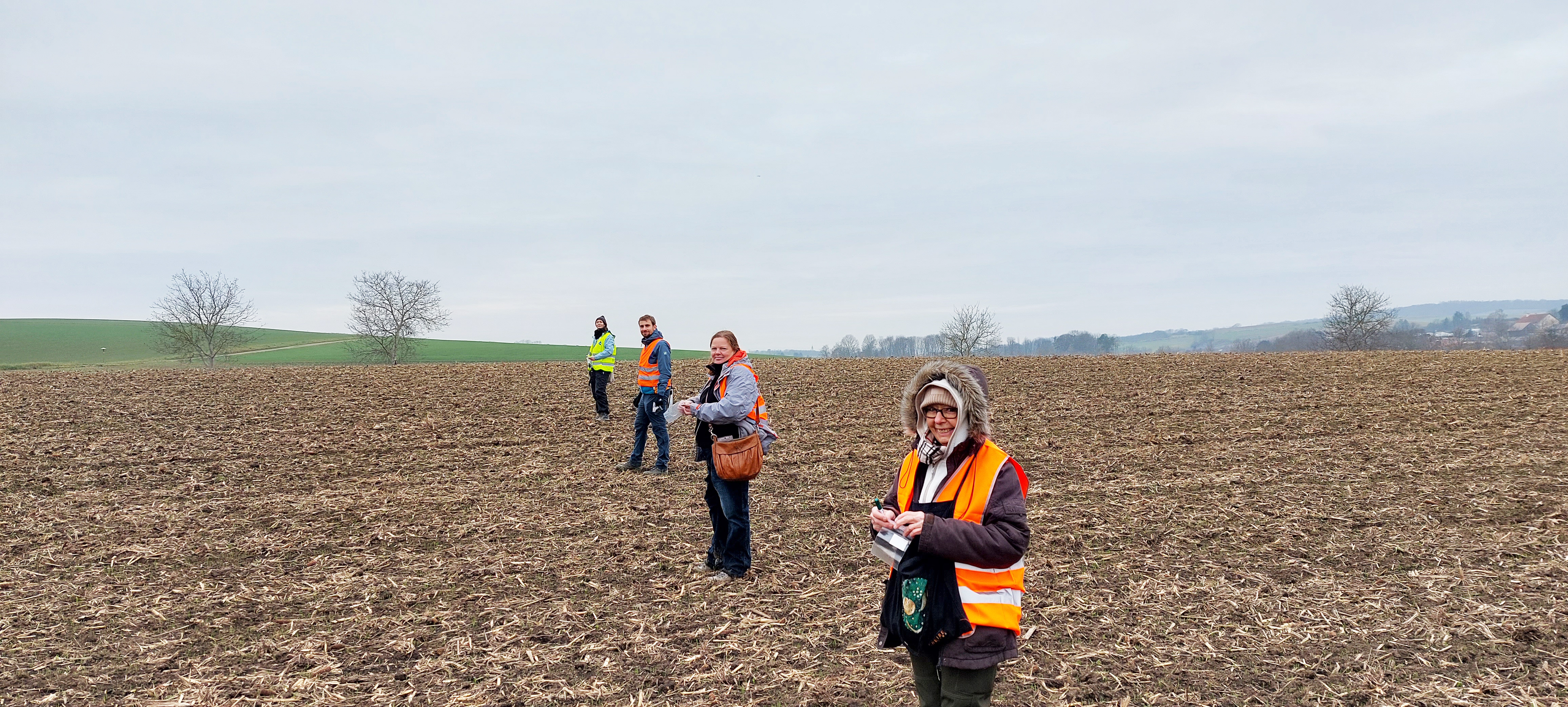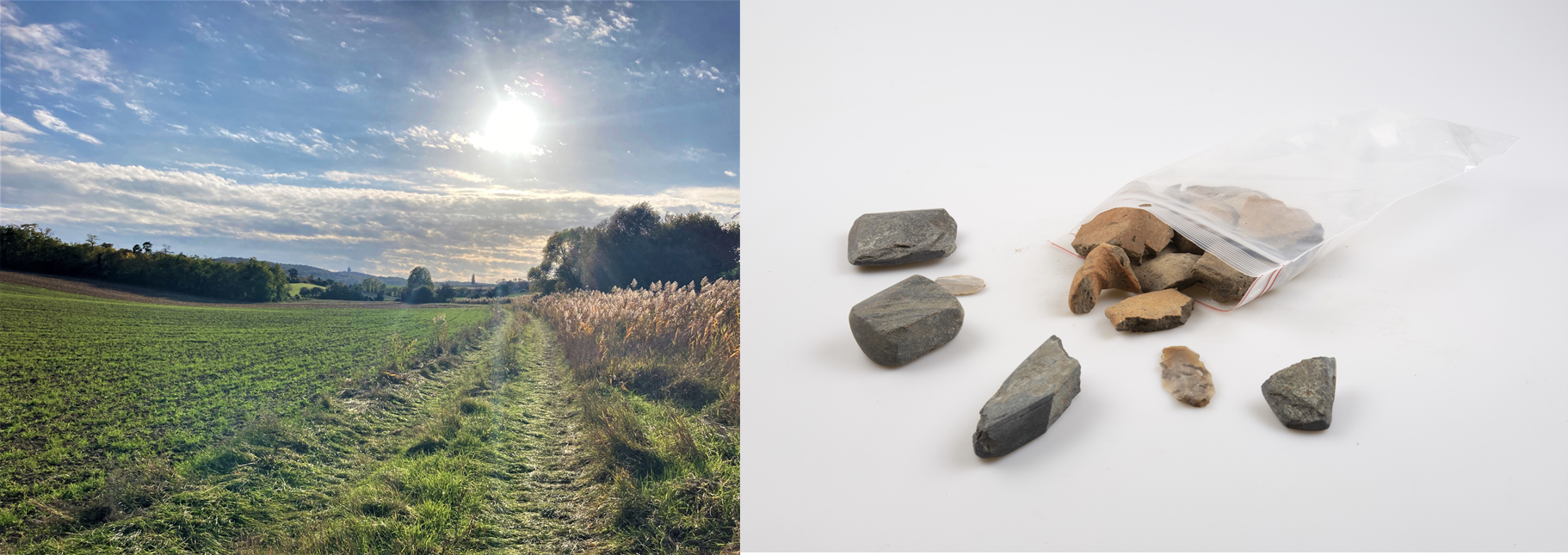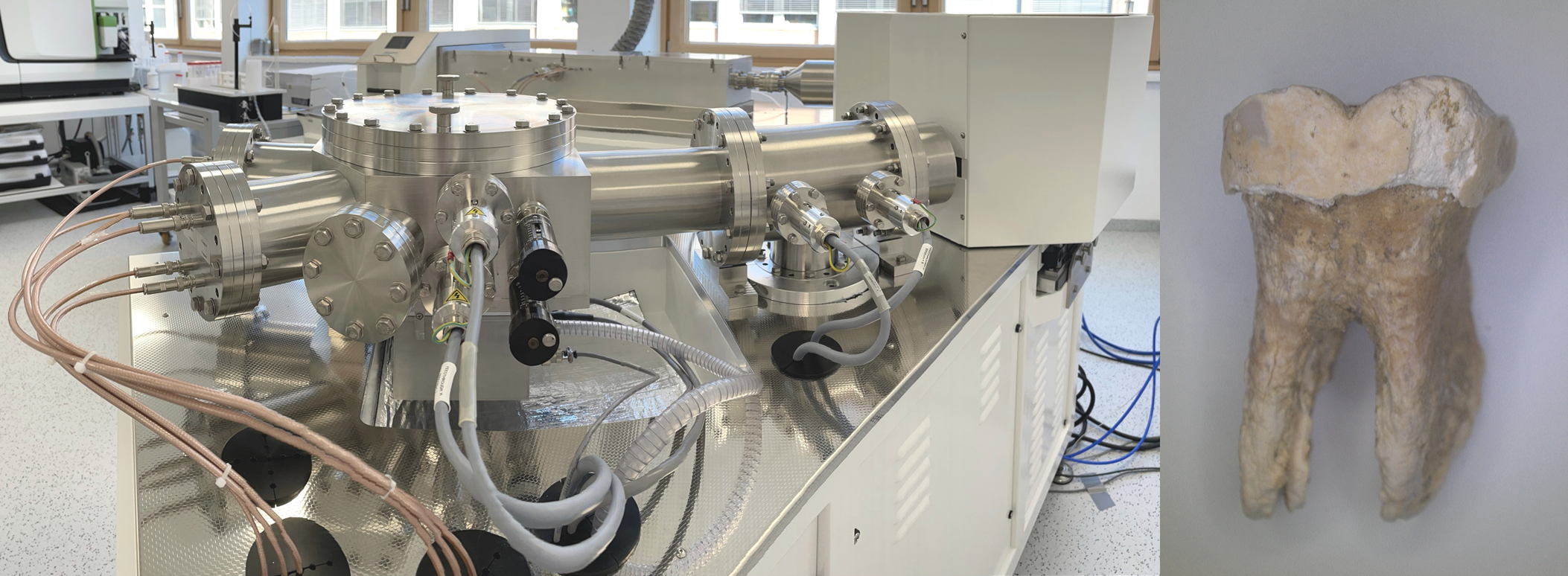
Motivation and scope of the project
 The project “United by crisis?” (UBC) aims to explore the surroundings of the famous Neolithic settlement of Asparn/Schletz (Lower Austria). Numerous human remains suggest a violent attack on this site in the Late Linear Pottery Culture (LPC), approx. 7.000 years ago.
The project “United by crisis?” (UBC) aims to explore the surroundings of the famous Neolithic settlement of Asparn/Schletz (Lower Austria). Numerous human remains suggest a violent attack on this site in the Late Linear Pottery Culture (LPC), approx. 7.000 years ago.
Due to its size and earthworks, we assume that Schletz was the central site of a cluster of smaller settlements in surrounding region. By researching these settlements, we hope, among other things, to increase our knowledge on the background of the massacre and on the origin of the people who died in Schletz. Visit our website www.united-by-crisis.at for further information & news on the project!
We cordially invite you to work with us as a Citizen Scientist!
In the project, we are searching for Neolithic finds (pottery, stone tools, etc.) at known or suspected sites near Asparn/Schletz together with interested people and collectors. During our surveys, we go over the fields at regular intervals and map the finds that we discover. Later on, we clean them together und create a scientific documentation and evaluation. Here you can find further information on how you can participate as a Citizen Scientist.
In another part of the project, local middle school students extract and process soil samples from the area of the LPC sites to create an isoscape (= isotope landscape). Through a comparison with Sr isotope ratios of the human remains, this will allow a discussion of whether the people that died in the massacre might have grown up locally or not.

Aims of the project
- Localization, dating and classification of early Neolithic sites in the vicinity of the LPC central site of Asparn/Schletz
- Determination of the bioavailable Sr isotope signals of the central site and the surrounding area
- Determination of the possible provenance and proportion of non-local individuals in the Schletz find ensemble
- Gaining knowledge on the social organization and development of the early Neolithic settlement cluster of Asparn/Schletz and its society
- Assessment of working hypotheses on the context of the Asparn/Schletz massacre, also as a case study for theoretical models on the development of societies and the supposed “crisis-situation” in the late LPC discussed by researchers
- Enhancing students' motivation and confidence in Science & STEM
- Promoting public interest in archaeology & knowledge sharing through active participation of members of the general public & collectors
Methods used in the project
- Systematic archaeological surveys (“line walking”)
- GIS modelling, research in literature, archaeological archives & find depots
- Statistical evaluation and dating of finds (typochronology, 14C, etc.)
- Determination of Sr-isotope ratios of human remains and soil samples (mass spectrometry - MC-ICP-MS)
- Bioanthropological studies on human remains

Project Members
- University for Continuing Education Krems, Center for Museum Collections Management (Lead)
- Montanuniversität Leoben, Chair of General and Analytical Chemistry
- University of Natural Ressources and Life Sciences Vienna, Institute of Soil Research, Campus Tulln
- Natural History Museum Vienna
- State Collections of Lower Austria
Cooperation partners
- MAMUZ
- School Center Asparn
- Österreich forscht
- University of Vienna, Department of Evolutionary Anthropology
Funded by

Details
| Duration | 01/10/2022 - 30/09/2025 |
|---|---|
| Funding | Bundesländer (inkl. deren Stiftungen und Einrichtungen) |
| Program |

|
| Department | |
| Principle investigator for the project (University for Continuing Education Krems) | Mag. Jakob Maurer |
| Project members | |
| Project website | https://www.united-by-crisis.at/ |
Team

Publications
Lindinger, V.; Längauer, J.; Sauter, K. (2024). Nicht bestellt, aber abgeholt. Eine mittelneolithische Kreisgrabenanlage auf einer linearbandkeramischen Siedlungsfundstelle in Zwentendorf an der Zaya. In: Franz Pieler/Jakob Maurer, Beiträge zum Tag der Niederösterreichischen Landesarchäologie 2024: 18–27, Land Niederösterreich – Landessammlungen Niederösterreich, St. Pölten
Maurer, J.; Längauer, J.; Duboc, O.; Hascher, C.; Irrgeher, J.; Prohaska, Th.; Puschenreiter, M.; Schober, M.; Teschler-Nicola, M.; Pieler, F. (2024). Walk the line. Erfolgsfaktor Citizen Science. In: Laussegger, A.; Sam, S., Im Bestand. Sammlungswissenschaftliche Einblicke. Tätigkeitsbericht 2023 der Landessammlungen Niederösterreich und des Zentrums für Museale Sammlungswissenschaften. 32-35, Landessammlungen Niederösterreich, St. Pölten
Maurer, J. (2024). United by Crisis? In: Dörler, Daniel; Heigl, Florian, Citizen Science Network Austria. Leistungsbericht 2023: 52–53, Österreich forscht, Wien
Maurer, Jakob; Längauer, Julia; Hascher, Cornelia; Irrgeher, Johanna; Teschler-Nicola, Maria; Prohaska, Thomas; Puschenreiter, Markus; Schober, Michael; Pieler, Franz (2023). United by Crisis? Eine transdisziplinäre Untersuchung der frühneolithischen Siedlungskammer von Schletz. In: Laussegger, Armin; Sam, Sandra, Im Bestand. Sammlungswissenschaftliche Einblicke. Tätigkeitsbericht 2022 der Landessammlungen Niederösterreich und des Zentrums für Museale Sammlungswissenschaften: 30–33, Landessammlungen Niederösterreich, St. Pölten
Maurer, Jakob (2023). United by Crisis? Dörler, Daniel; Heigl, Florian, Citizen Science Network Austria. Leistungsbericht 2022: 38–39, Wien
Maurer, Jakob; Längauer, Julia (2023). Forschung mit Freiwilligen: 7.000 Jahre alter Kriminalfall im Weinviertel. https://www.derstandard.at/wissenschaft/wissensblogs/archaeologieblog
Lectures
Das jungsteinzeitliche „Massaker von Asparn/Schletz“ – transdisziplinäre Forschung mit Citizen Scientists
Citizen Science Seminar of BOKU University & Österreich forscht, 22/01/2025
Krise, 3D und Kupferzeit
Jahresrückblick 2024 "Archäologie in Niederösterreich", 05/12/2024
Von Feldern und Funden – neue Ergebnisse der Line Walking Surveys im oberen Zayaraum
Jahresrückblick 2024 "Archäologie in Niederösterreich", 05/12/2024
Die linearbandkeramische Siedlungskammer von Asparn-Schletz. Neues vom Projekt „United by Crisis“?
MAMUZ-Finissage, 22/11/2024
Die neuen C14-Daten für das Projekt „United by Crisis?“
MAMUZ-Finissage, 22/11/2024
Defining structure of a “central site”? Stratigraphy, architecture and function(s) of the ditches surrounding Asparn/Schletz
30th Annual Meeting of the European Association of Archaeologists, 30/08/2024
Ditch, Pit, Grave: On the burial practices in the settlement of Asparn-Schletz and further LBK sites in Lower Austria
30th Annual Meeting of the European Association of Archaeologists, 30/08/2024
Indications of a crisis? Updated evidence drawn from the human remains discovered at Asparn/Schletz
30th Annual Meeting of the European Association of Archaeologists, 30/08/2024
Surrounding a LBK-“Central Site”. First results on the diachronic and spatial development of the “Schletz settlement cluster”/Lower Austria
30th Annual Meeting of the European Association of Archaeologists, 30/08/2024
Trade Hub? Save Haven? Ritual Centre? The Role of Ditch Systems and Central Sites in the Neolithic (Conference-Session)
30th Annual Meeting of the European Association of Archaeologists, 30/08/2024
„Durch die Krise vereint?“ Projektpräsentation mit der 4a & 4b der NMS Asparn/Z.
Abschlussfest von "United by Crisis?" mit dem Schulzentrum Asparn/Zaya, 20/06/2024
Nicht bestellt, aber abgeholt. Eine mittelneolithische Kreisgrabenanlage auf einer linearbandkeramischen Siedlungsfundstelle in Zwentendorf an der Zaya
Tag der Niederösterreichischen Landesarchäologie, 01/06/2024
Wie alt ist dieser archäologische Fund?
Lange Nacht der Forschung MAMUZ Schloss Asparn/Z., 24/05/2024
Wie findet man eine 7.000 Jahre alte Siedlung?
Lange Nacht der Forschung MAMUZ Schloss Asparn/Z., 24/05/2024
„Steinzeitstream“ – „Durch die Krise vereint?“ Projektpräsentation mit der 4a & 4b der NMS Asparn/Z.
Science Fair 2024, 23/05/2024
"Tu Felix Austria Nube" – (Female) Mobility as a Means of Conflict Avoidance in the LBK
International Conference “Fight or Flight. The archaeology of space, mobility, and violence”, 24/04/2024
Interpretationsworkshop „Steinzeitstream. Dokumentation interdisziplinärer Forschungen zur archäologischen Fundstelle Asparn/Schletz“
Science-Workshop des Projekts "United by Crisis?" mit dem Schulzentrum Asparn/Z., 03/04/2024
Uralt oder doch was neues? Citizen Science in der Archäologie
Jahresrückblick 2023 "Archäologie in Niederösterreich", 23/11/2023
Chemie und Bodenkunde – mit Kindern in die Steinzeit!
MAMUZ-Finissage, 17/11/2023
Erste Ergebnisse der Line Walking Surveys mit Citizen Scientists im nördlichen Weinviertel
MAMUZ-Finissage, 17/11/2023
Linien – Daten – Zeit. Verarbeitung von Line Walking Survey-Daten in GIS und Ausblick auf die C14-Beprobungen
MAMUZ-Finissage, 17/11/2023
Waterways in the Early Neolithic Weinviertel – small rivers and rivulets usage in the LBK of Lower Austria
Central Europe TAG (Theoretical Archaeology Group) 2023, 10/11/2023
Wie erkenne ich archäologische Funde?
Forschungsfest Niederösterreich, 22/09/2023
Analyse von Erdproben
Science-Workshop des Projekts "United by Crisis?" mit dem Schulzentrum Asparn/Zaya, 12/09/2023
Lurking on the edge of practice: Vocabulary instincts from between archaeological research, museum documentation and development-led archaeology
29th Annual Meeting of the European Association of Archaeologists, 01/09/2023
Evidence of Cranial Surgery 5000 BC at Schletz/Lower Austria
29th Annual Meeting of the European Associaton of Archaeologists, 31/08/2023
Walk the line: First experiences with multiple Citizen Science target-groups in the transdisciplinary LBK research project “United by Crisis?”
29th Annual Meeting of the European Association of Archaeologists, 31/08/2023
“Centres and peripheries” of the LBK in northern Lower Austria – current projects and first results
29th Annual Meeting of the European Association of Archaeologists, 31/08/2023
Chemie und Bodenkunde
Science-Workshop des Projekts "United by Crisis?" mit dem Schulzentrum Asparn/Zaya, 24/05/2023
Ernährung in der Jungsteinzeit
Science-Workshop des Projekts "United by Crisis?" mit dem Schulzentrum Asparn/Zaya, 03/05/2023
Das Projekt "United by Crisis?" - Tätigkeiten und Organisation
Eröffnungsworkshop des Projekts "United by Crisis?" mit Citizen Scientists, 04/03/2023
Funderkennung und Surveymethodik
Eröffnungsworkshop des Projekts "United by Crisis?" mit Citizen Scientists, 06/02/2023
Interdisziplinäre Entwicklung neuer Methoden zur Digitalisierung & United by Crisis?
Jahresrückblick 2022 "Archäologie in Niederösterreich", 01/12/2022
Durch die Krise vereint
Mamuz Finissage, 17/11/2022
Interdisziplinäre Entwicklung neuer Methoden zur Digitalisierung & Durch die Krise vereint?
MAMUZ-Finissage, 17/11/2022
United by crisis? A transdisciplinary look at the early Neolithic communities in the Schletz settlement cluster, Austria
28th Annual Meeting of the European Associaton of Archaeologists, 03/09/2022
United by crisis? A transdisciplinary look at the early Neolithic communities in the Schletz settlement cluster, Austria
28th Annual Meeting of the European Associaton of Archaeologists, 03/09/2022
Asparn-Schletz. Die Erforschung einer steinzeitlichen Siedlungslandschaft im Weinviertel
Erlebniswochenende "Archäo Basis: Neu im MAMUZ Schloss Asparn/Zaya", 21/08/2022